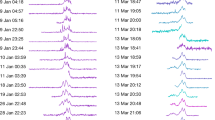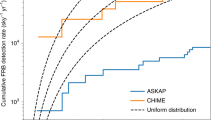Abstract
The radio sky is relatively unexplored for transient signals1, although the potential of radio-transient searches is high. This was demonstrated recently by the discovery of a previously unknown type of source2,3, varying on timescales of minutes to hours. Here we report a search for radio sources that vary on much shorter timescales. We found eleven objects characterized by single, dispersed bursts having durations between 2 and 30 ms. The average time intervals between bursts range from 4 min to 3 h with radio emission typically detectable for <1 s per day. From an analysis of the burst arrival times, we have identified periodicities in the range 0.4–7 s for ten of the eleven sources, suggesting origins in rotating neutron stars. Despite the small number of sources detected at present, their ephemeral nature implies a total Galactic population significantly exceeding that of the regularly pulsing radio pulsars. Five of the ten sources have periods >4 s, and the rate of change of the pulse period has been measured for three of them; for one source, we have inferred a high magnetic field strength of 5 × 1013 G. This suggests that the new population is related to other classes of isolated neutron stars observed at X-ray and γ-ray wavelengths4.
This is a preview of subscription content, access via your institution
Access options
Subscribe to this journal
Receive 51 print issues and online access
$199.00 per year
only $3.90 per issue
Buy this article
- Purchase on Springer Link
- Instant access to full article PDF
Prices may be subject to local taxes which are calculated during checkout


Similar content being viewed by others
References
Cordes, J. M., Lazio, T. J. W. & McLaughlin, M. A. The dynamic radio sky. New Astron. Rev. 48, 1459–1472 (2004)
Hyman, S. D. et al. A powerful bursting radio source towards the Galactic Centre. Nature 434, 50–52 (2005)
Kulkarni, S. R. & Phinney, E. S. Astronomy: blasts from the radio heavens. Nature 434, 28–29 (2005)
Woods, P. M. & Thompson, C. in Compact Stellar X-Ray Sources (eds Lewin, W. & van der Klis, M.) (Cambridge Univ. Press, in the press)
Cordes, J. M., Bhat, N. D. R., Hankins, T. H., McLaughlin, M. A. & Kern, J. The brightest pulses in the Universe: multifrequency observations of the Crab pulsar's giant pulses. Astrophys. J. 612, 375–388 (2004)
Lorimer, D. R. & Kramer, M. Handbook of Pulsar Astronomy (Cambridge Univ. Press, 2005)
Johnston, S. & Romani, R. W. Giant pulses from PSR B0540-69 in the Large Magellanic Cloud. Astrophys. J. 590, L95–L98 (2003)
Haberl, F. AXPs and X-ray-dim isolated neutron stars: recent XMM-Newton and Chandra results. Adv. Space Res. 33, 638–644 (2004)
McLaughlin, M. A. et al. PSR J1847-0130: a radio pulsar with magnetar spin characteristics. Astrophys. J. 591, L135–L138 (2003)
Kaplan, D. L. & van Kerkwijk, M. H. A coherent timing solution for the nearby isolated neutron star RX J0720.4-3125. Astrophys. J. 628, L45–L48 (2005)
NASA's HEASARC: Archive. http://heasarc.gsfc.nasa.gov/docs/archive.html (2005).
Lorimer, D. R. in Young Neutron Stars and Their Environments (eds Camilo, F. & Gaensler, B. M.) 105, 105–112 (IAU Symp. 218, Astronomical Society of the Pacific, San Francisco, 2004)
Lyne, A. G. et al. The Parkes Southern Pulsar Survey II. Final results and population analysis. Mon. Not. R. Astron. Soc. 295, 743–755 (1998)
Tauris, T. M. & Manchester, R. N. On the evolution of pulsar beams. Mon. Not. R. Astron. Soc. 298, 625–636 (1998)
Vranesevic, N. et al. Pulsar birthrates from the Parkes Multibeam Survey. Astrophys. J. 617, L139–L142 (2004)
Cordes, J. M. & Lazio, T. J. W. NE2001. I. A new model for the Galactic distribution of free electrons and its fluctuations. Preprint at http://arxiv.org/astro-ph/0207156 (2002).
Soglasnov, V. A. Giant pulses from PSR B1937 + 21 with widths less than 15 nanoseconds and T greater than 5 × 1039 K, the highest brightness temperature observed in the Universe. Astrophys. J. 616, 439–451 (2004)
Hankins, T. H., Kern, J. S., Weatherall, J. C. & Eilek, J. A. Nanosecond radio bursts from strong plasma turbulence in the Crab pulsar. Nature 422, 141–143 (2003)
Hobbs, G. et al. The Parkes multibeam pulsar survey—IV. Discovery of 180 pulsars and parameters for 281 previously known pulsars. Mon. Not. R. Astron. Soc. 352, 1439–1472 (2004)
Manchester, R. N. et al. The Parkes multi-beam pulsar survey—I. Observing and data analysis systems, discovery and timing of 100 pulsars. Mon. Not. R. Astron. Soc. 328, 17–35 (2001)
Cordes, J. M. & McLaughlin, M. A. Searches for fast radio transients. Astrophys. J. 596, 1142–1154 (2003)
Acknowledgements
The Parkes radio telescope is part of the Australia Telescope, which is funded by the Commonwealth of Australia for operation as a National Facility managed by CSIRO. A.P. and N.D'A. acknowledge financial support from the Italian Ministry of University and Research (MIUR). F.C. is supported by NSF, NASA and NRAO. D.R.L. is a University Research Fellow funded by the Royal Society. I.H.S. holds an NSERC UFA and is supported by a discovery grant.
Author information
Authors and Affiliations
Corresponding author
Ethics declarations
Competing interests
Reprints and permissions information is available at npg.nature.com/reprintsandpermissions. The authors declare no competing financial interests.
Supplementary information
Supplementary Figure 1
Burst observational signatures in frequency and time. (PDF 1723 kb)
Supplementary Figure 2
Typical burst intensities. (PDF 775 kb)
Supplementary Figure Legends
Full text to accompany the above Supplementary Figures. (PDF 49 kb)
Rights and permissions
About this article
Cite this article
McLaughlin, M., Lyne, A., Lorimer, D. et al. Transient radio bursts from rotating neutron stars. Nature 439, 817–820 (2006). https://doi.org/10.1038/nature04440
Received:
Accepted:
Issue Date:
DOI: https://doi.org/10.1038/nature04440
This article is cited by
-
Quasi-periodic sub-pulse structure as a unifying feature for radio-emitting neutron stars
Nature Astronomy (2023)
-
Antennas for low-frequency radio telescope of SKA
Journal of Astrophysics and Astronomy (2023)
-
Radio pulsations from a neutron star within the gamma-ray binary LS I +61° 303
Nature Astronomy (2022)
-
Radio pulsar sub-populations (II): The mysterious RRATs
Journal of Astrophysics and Astronomy (2022)
-
Radio pulsar sub-populations (I): The curious case of nulling pulsars
Journal of Astrophysics and Astronomy (2019)
Comments
By submitting a comment you agree to abide by our Terms and Community Guidelines. If you find something abusive or that does not comply with our terms or guidelines please flag it as inappropriate.



